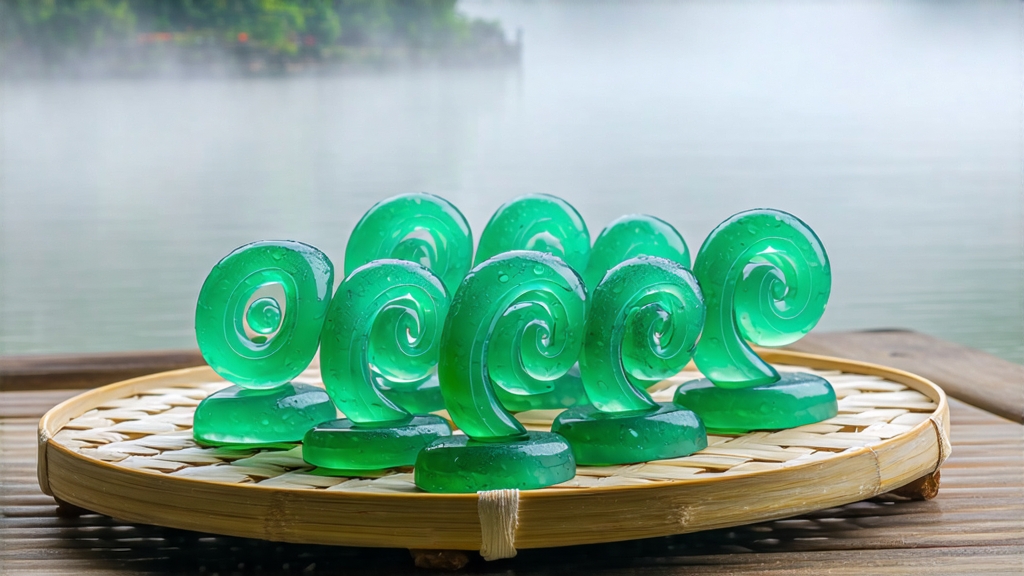
Biluochun, whose name translates literally to “Green Snail Spring,” is one of China’s ten most celebrated teas, yet it remains a delicate secret outside serious tea circles. Grown on the mist-locked, fruit-tree-capped hills that ring East China’s Taihu Lake, this emerald-green tea is prized for its tiny, tightly rolled spirals, an aroma that carries the perfume of apricot and plum blossoms, and a taste so soft and lingering that the Qing-dynasty Emperor Kangxi is said to have renamed it on the spot when it was first presented at court in 1699. For international drinkers accustomed to the vegetal punch of Sencha or the nutty sweetness of Longjing, Biluochun offers a gentler, more floral path into the universe of Chinese green tea.
1. Historical vignette
Although commercial production around Dongting Mountain in Jiangsu province is documented only from the late Ming dynasty (17th century), local monks speak of “Xia Sha Ren Xiang” (literally “scary fragrance”)—an earlier wild tea so aromatic that it startled meditators. When Kangxi’s retinue passed through Suzhou in 1699, magistrate Song Luo offered the finest spring picking. The emperor found the name crude and rechristened it “Biluochun,” fusing the place name “Biluo Peak” with “chun,” meaning spring. The new name stuck, and imperial favor catapulted the tea onto tribute lists, ensuring its survival through centuries of dynastic change.
2. Terroir and micro-climate
Taihu Lake, China’s third-largest freshwater body, acts as a gigantic climate regulator. Morning mist slows photosynthesis, forcing the plant to accumulate amino acids—especially L-theanine—yielding sweetness and umami instead of harsh tannins. The hills rise steeply from the water, so orchards of loquat, peach, and apricot interlace with tea gardens; their roots share the same acidic, well-drained lateritic soil, and their blossoms become part of the tea’s natural aromatics. No other Chinese green tea is as influenced by surrounding fruit trees, giving Biluochun its signature “ floral within fruity” bouquet.
3. Cultivars and grades
The original landrace is the small-leaf “Dongting群体种” (qunti zhong), still propagated by seed for complexity. Since the 1980s, clonal selections such as “Dongting #7” and “Dongting #9” have been introduced for higher yield and frost resistance. Grading follows picking standard and time:
- Special Grade (特级): one bud plus an unfolding leaf ≤1.5 cm, plucked before Qingming (early April).
- Grade 1: one bud plus one leaf ≤2 cm, picked before Grain Rain (late April).
- Grade 2: one bud plus two leaves, still spiral but slightly larger.
Only about 100 tons of authentic lake-core tea are made each spring; ten times that amount is sold, so provenance is critical.
4. Crafting the spiral
Biluochun is the last major Chinese green tea still largely hand-finished. The entire process must be completed within four hours of plucking to lock in fragrance.
Step 1: Withering
Leaves are spread 2 cm thick on bamboo trays in shaded draft for 30–45 minutes, reducing moisture by ~10 % and softening cell walls.
Step 2: Pan-killing green (杀青)
A 200 °C cast-iron wok is swabbed with local camellia oil. The tea master tosses 250 g of leaves with a rhythmic clap that sounds like rain on a tin roof. In 3–4 minutes, enzymes are deactivated, yet 55 % moisture remains.
Step 3: Rolling & spiraling (揉捻显毫)
While still hot, the leaves are rolled between palm and wok, first lightly, then with increasing pressure. The trick is to curl the bud into a tight spiral without breaking the tip—hence the iconic “white down” (毫) that coats each snail. This step lasts 12–15 minutes and determines both appearance and mouthfeel.
Step 4: Re-firing (搓团显毫)
Small portions are rubbed in circular motions until they form pellet-like clusters. Temperature drops progressively from 70 °C to 50 °C, locking in aroma while further reducing moisture to 20 %.
**Step 5: